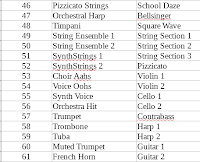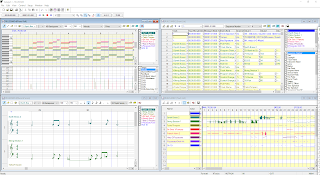 |
| Left General Midi, Right Roland MT32 |
Even though Yamaha really isn't in this picture, that company's changes were a little more standard and some of the extensions made sense. For example, you could have more that 128 sounds, but made it so the percussion track wasn't hard-coded to the 10th track. You had to map a drum kit instrument to the track instead.
I contemplated just rendering the music though an MT-32 emulator. Sadly, the sound samples are copyrighted by Roland and they have been known to get litigious in the past about using their samples in an emulator. It appears I will need to slightly resequence the title music to have it conform to General Midi. This includes patching the instruments back, which I have done, but I also need to remap the controllers (Volume, Pan, Sustain) and scrub the proprietary Roland SysEx (System Executive) events. This is why my volumes, sustains, and pans were all over the place.
 The good news is I have a better sequence editor. The other one I had was pretty basic and just gave me the ability to edit the piano scroll and some tracking elements. The one I have now has a track editor, piano scroll editor, notation, and the ability to manually edit the event timeline. It's the event editor that is the most useful. It's also the oldest of old-school ways of editing MIDI. Back in the day, the event list was all I had on the Apple II.
The good news is I have a better sequence editor. The other one I had was pretty basic and just gave me the ability to edit the piano scroll and some tracking elements. The one I have now has a track editor, piano scroll editor, notation, and the ability to manually edit the event timeline. It's the event editor that is the most useful. It's also the oldest of old-school ways of editing MIDI. Back in the day, the event list was all I had on the Apple II.I'll be playing catch up the weekend and hopefully have a nice sounding title theme when I'm done.
No comments:
Post a Comment